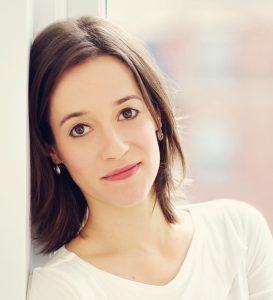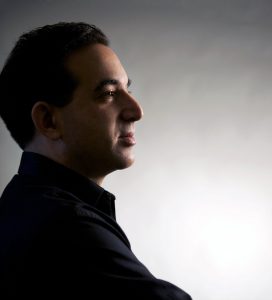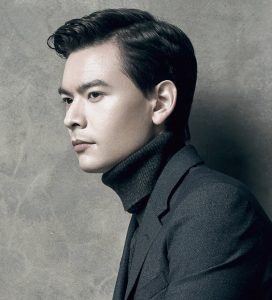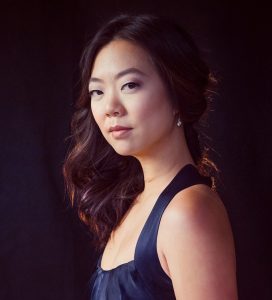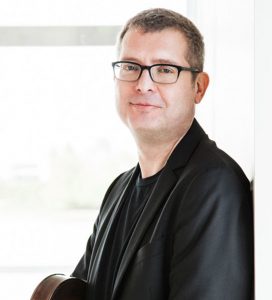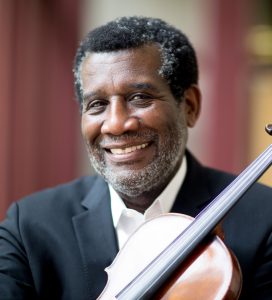Ludwig van BEETHOVEN Clarinet Trio in B-flat major, Op. 11 (1798)
Romie de Guise-Langlois, clarinet; Raman Ramakrishnan, cello; Max Levinson, piano
Johannes BRAHMS Piano Trio No. 3 in C minor, Op. 101 (1886)
Stefan Jackiw, violin; Raman Ramakrishnan, cello, Max Levinson, piano
Arnold SCHOENBERG Verklärte Nacht, Op. 4 (1899)
Alyssa Wang, violin; Stefan Jackiw, violin; Marcus Thompson, viola; David Harding, viola; Raman Ramakrishnan, cello; Thomas Van Dyck, double bass
Featured musicians
In Beethoven’s Clarinet Trio, a genial work from the composer’s early period, its opening Allegro and serene Adagio each demonstrates a clear sonata form, while the last movement is a theme and variations based on a popular song, “Pria ch’io l’impegno,” by Joseph Weigl.
Brahms’s Piano Trio No. 3 in C minor gives economical expression to various transformations of a four-note motive, voiced explosively in the piano at the work’s outset and serving as a thematic anchor throughout. The third movement’s grace and tenderness are packaged in a highly uncommon meter — effectively 7/4 — that brings a notable rhythmic inventiveness to this work.
In Schoenberg’s Verklärte Nacht, six string instruments conjure the atmosphere of a couple walking in a moonlit night, exchanging a range of passionate emotions. Based on the eponymous poem by Richard Dehmel, Verklärte Nacht is a rare example of a tone poem in the chamber music literature and remains Schoenberg’s most popular and approachable work.
Full Program Notes
Ludwig van Beethoven
(Bapt. December 17, 1770–March 26, 1827)
Beethoven completed the Clarinet Trio in 1798 and dedicated it to Countess Maria Wilhelmine von Thun, pianist and patron to both Mozart and Beethoven and mother-in-law to Prince Karl Lichnowsky, himself an important patron of Beethoven. Lewis Lockwood refers to the Trio as a “full-bodied trifle,” but this is only to highlight that even as early as the 1790s, some of Beethoven’s other works were already causing a stir and his reputation as a radical, while nascent, was already being brewed in the press. Through that lens, Op. 11 is well-behaved in its adherence to classical principles, and the third movement set of variations does cast the work as more of a divertimento.
The opening Allegro con brio is in very straightforward sonata form, a textbook, if not somewhat clichéd, example of Beethoven’s “early” period. Motives are established then echoed in the three instruments. The clarinet’s presence is particularly noticeable in the second theme area. The development is marked by a momentary move to D-flat, using the second theme’s motive of triadic ascent. Beethoven then flips that on its head with a series of staccato descending gestures in the cello and clarinet that also articulate triads in their first three notes. The idea transfers to the left hand of the piano under repeated arpeggiations as the cello and clarinet offer graceful extensions. A quaint coda recalls glimmers of thematic material before a final flourish in the piano lands without ceremony in B-flat.
The cello and piano in E-flat showcase Beethoven’s gifts for lyrical slow movements in the opening of the Adagio. The clarinet takes up the theme with soft contrapuntal responses from the other two instruments. A shift to the minor key with flowing triplets in the piano’s left hand offers a change in emotion with imploring gestures in the clarinet. The movement ends morendo, with a seemingly “extra” bit tacked on to the end, prefiguring Beethoven’s love for prolonged cadences.
The last movement is what sometimes affords the trio the subtitle “Gassenhauer,” as it is a theme and variations on a jaunty little song “Pria ch’io l’impegno,” which comes from Joseph Weigl’s comic opera L’amor marinaro (The Sailor’s Love) of 1797. Weigl was successor to Salieri at the court theater as Kapellmeister, and he was the godson of Haydn as well. The tune has been somewhat incorrectly identified in certain sources as a popular song, but in truth, the song likely did achieve pop song status as the opera was performed in all the major large theaters in Europe. Given that both Beethoven and Joseph Eybler used the tune in 1798 (the latter composing a set of ten variations for piano), we can assume it was a hit of the day. Paganini followed suit thirty years later with his Sonata and Variations on the same tune.
The piano introduces the theme (only subtly altered from the original by Beethoven), then heard in the clarinet. In the first variation piano solo fills out the theme with graceful arpeggiations and scalar figures, closing with the fun spirit innate to the theme. The cello offers a melodic variation, then heard in the clarinet, while the piano remains tacet in the second variation. The clarinet’s con fuoco alarm that signals the third variation sounds above flowing arpeggiations in the piano. The cello takes its turn, before the two instruments have a short dialogue. Variation four turns to the minor key and seems to inject some seriousness into the movement that seems rather fleeting upon the entrance of the fifth variation and the return to the cheerful major key. The rhythmic variation that follows comprises mostly dyads that seem playful, but not mocking. The dramatic dotted rhythm octave jump in the cello that marks the seventh variation heralds a second minor key variation built upon that same motive. Variation eight features a more extensive bipartite variation with a clearly expressed melody in the clarinet and cello. The final variation returns to the staccato articulation of the opening theme, but a prolonged set of trills in the piano and cadenza-like flourishes lead to a syncopated Allegro in 6/8. All three instruments join in to round out the movement.
Johannes Brahms
(May 7, 1833–April 3, 1897)
This work by Brahms, written in 1886 whilst vacationing in Switzerland, is often cited as an exemplar of mature Brahmsian tactics: developing variation, chromatic ingenuity, and “economical lyricism” to quote Brahms scholar Walter Frisch. The developing variation finds its roots in the opening measures of the Allegro energico, which supplies generative ideas in the three note groupings in the piano as well as the dotted rhythm that soon comes galloping in. This fanfare is the most emphatic aspect of the entire piece, and gives way to a contrasting secondary cantando theme that is nevertheless related in its ascending scalar motion derived from the opening. The recapitulation of the movement returns to both themes but embellishes and develops them, befitting Brahms’s mature style.
The two ternary form inner movements seem to be related in intent to each other (both have been cited as “intermezzi” by a variety of commentators), and it is clear both are meant to be inniglich, particularly in contrast to the first movement. The Presto non assai, which Clara Schumann found “wonderfully poetic,” starts with muted strings while the piano takes a gentle leading role. Ascending pizzicato lines demarcate the middle section that is characterized by syncopated figures in the piano and strings. A gradual diminuendo to triple piano returns to the C minor opening with an almost melancholy descending line in the piano as the opening motive seemingly floats off into the distance. The C major opening of the Andante grazioso helps create harmonic and lyrical contrast, but like the second movement, the andante maintains its intimacy. The lullaby-like movement features a graceful duet between the violin and cello that is then taken up by the piano. Brahms exploits this dialogic grouping and evokes a harp in the rolled chords in the keyboard to illuminate the textural and expressive capacity of the genre. The almost imperceptible change from alternating simple meters to alternating compound meters features the violin marking the triple feel in slow dotted quarters while the cello marks the compound groupings. Passages of leaping octaves seem to imply a momentum toward great contrast, but Brahms maintains the reverie, with only the final two chords in C major offering a resolute ending.
The allegro molto revisits the energy of the first movement with a comparable contrasting second theme. Harmonically adventurous, the movement is almost fantasia-like in the variety of figurations. Here Brahms is “teasing out” the possibilities for development and variation on a micro-scale. The movement keeps us guessing, with a brief and noticeable flirtation with C major (in the form of “three blind mice” chords), only to return to the opening material in C minor. Despite the restrained tone of much of the work, Brahms ends the piece in a victorious C major.
Arnold Schoenberg
(September 13, 1874–July 13, 1951)
“My Verklärte Nacht, written before the beginning of this century—hence a work of my first period, has made me a kind of reputation. From it I can enjoy (even among opponents) some appreciation which the works of my later periods would not have procured for me so soon. This work has been heard, especially in its version for orchestra, a great many times. But certainly nobody has heard it as often as I have heard this complaint: ‘If only he had continued to compose in this style!’” —Arnold Schoenberg, “How One Becomes Lonely” (1935)
While humorous, it is somewhat disingenuous to allow the above quote to remain without the follow-up prose from the composer, because it makes an important point about both Verklärte Nacht and what was to come:
“The answer I gave is perhaps surprising. I said: ‘I have not discontinued composing in the same style and in the same way as at the very beginning. The difference is only that I do it better now than before; it is more concentrated, more mature.“
While Schoenberg would become known as the “emancipator of dissonance” and Verklärte Nacht predates his true experiments in atonality (or better, pantonality), Schoenberg’s commentary is revealing. The piece bears the earmarks of Wagner, yes, but it also demonstrates Schoenberg’s already more-expansive concepts of chromaticism in its barely deferential nod to D minor. A tone poem for chamber ensemble, later arranged for orchestra, Verklärte Nacht (Transfigured Night) takes as its inspiration a poem by Richard Dehmel (1863–1920). The programmaticism aligns with the five sections of the poem, but without overt representation, instead blending both expressionism and symbolism in its attention to emotional states and the primary sensory aspects of the poem (e.g. moonlight).
(Dehmel’s Verklärte Nacht, in original German and English translation.)
The moon, an object of fixation for many a German symbolist, figures prominently in the first part of Dehmel’s poem, wherein a pair of lovers, a man and a woman, are walking in a wood and the moon läuft mit—runs/moves with them. It is this atmosphere to which Schoenberg is attuned. Marked “Sehr langsam,” the first section starts quietly in the low strings, and the composer cautions, “immer leise” (always quiet), not allowing the darkness to relent until the shimmering trills in the first violin. The chromaticism is gentle here, but drama and tension build as the viola introduces a somber warning. The texture seems to saturate with moonlight until an abrupt pizzicato shifts the mood, with the first viola offering a descending cry that leads to a section of muted strings. Repeated unmuted descending figures seem to be dragging the scene toward something dreadful, and the tension, when it isn’t building, is always there, murmuring as a harbinger of what is to come.
In the second part of Dehmel’s poem we learn that the woman is pregnant with another man’s child. She offers this confession to her lover, pleading that it was only her deep desire to be a mother that led to her sin, not anticipating falling in love with her current partner. Schoenberg marks the section “Breiter” and it opens with major key brilliance, but the brief moment of joy soon takes on tense urgency as the confession comes tumbling out. Angular and jagged lines, along with menacing tremolos and pizzicatos transform the atmosphere. The tumult culminates in a triple forte declamation in all six instruments. The density relents, only to be replaced by emphatic pleading figures in the first violin. The tension quiets to settle into the third section.
Marked “Schwer betont” (heavily emphasized), the sense of heavy plodding footsteps captures the weight of her confession. The upper strings bring back the moonlight from the first section, and so too in the poem: Sie schaut empor; der Mond läuft mit (She looks up, the moon moves with her). The strings shimmer in their higher tessituras before a momentary cadence.
The fourth and longest section, “Sehr breit und langsam,” opens with a warm and resonant chordal prayer, and we understand that this unabashed tonality is the man affirming that he will accept the child as his own. The child will be “transfigured” by the warmth of the love that surrounds them. Whispery flageolet violas and muted violins ascend (then repeated in cellos and violas), leading to an emotional transformation as the inner feelings of the couple meet the splendor of the universe in hopeful, melodic exchanges. This leads to an intriguing four bars that Schoenberg marks “Etwas gedehnt” (somewhat stretched) and directs the players to play on the fingerboard. This provides an eerily magical bridge to another motivic exchange between cello and viola. The first violin offers a lovely “innig und warm” passage into a steadier tempo. The chromatic relationships here are not restless and unnerving, but instead provide harmonic interest nestled in amongst the more romantically rhetorical melodic expressions. Light and hopeful skipping figures take over until they change into more insistent and passionate gestures. The harmonies grow more dissonant as the texture seems electrified by thirty-second-note ascents in the cello and viola against sixteenth notes in the other four instruments. All the turmoil seems to come to rest in a D major chord, with a tender melodic gesture working its way through the texture even as the harmonies become more chromatic, but also conciliatory.
All is well in the final section, “Sehr ruhig,” as the couple embraces. Schoenberg cleverly chromatically alters the descending chromatic lines from the opening movement—the moon is still present as in Dehmel’s poem, but now the pair continues their walk resolved, transfigured.
While by the 1930s Verklärte Nacht may have seemed old-fashioned, at least in terms of Schoenberg’s oeuvre, in 1902, when the piece premiered, it was not without its detractors. The use of Dehmel’s 1896 poem certainly caused a stir amongst the more conservative Viennese audience at the Musikverein, as it seemed to condone pre-marital sex, and Schoenberg’s music did little to critique that issue. On December 12, 1912, Richard Dehmel wrote to Schoenberg: “Yesterday I heard Transfigured Night, and I should consider it a sin of omission if I failed to say a word of thanks to you for your wonderful sextet. I had intended to follow the motives of my text in your composition; but I soon forgot to do so. I was so enthralled by the music.”
© 2024 Rebecca G. Marchand

